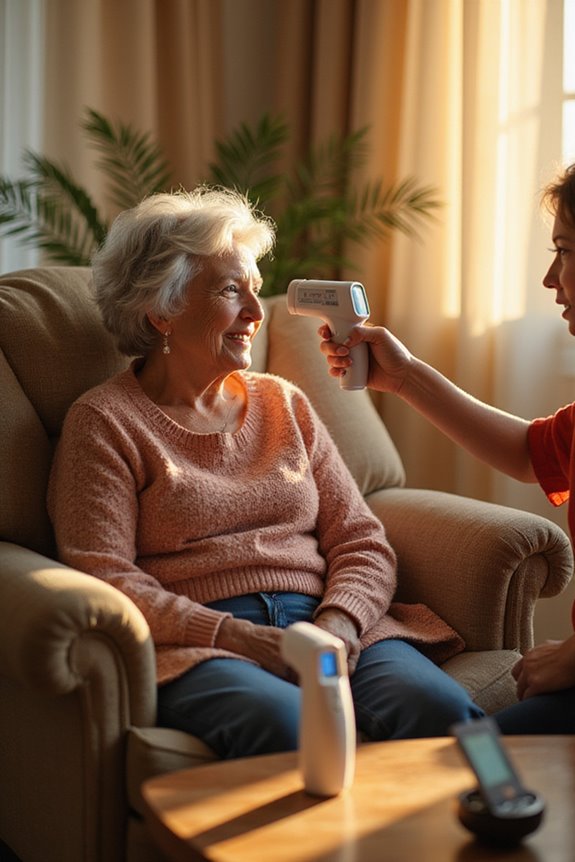A dual-mode thermometer offers significant advantages, warranting the extra cost for many users. It combines multiple temperature measurement methods, ensuring precision within ±0.2°C. The rapid response time of one second enhances efficiency in critical situations. With features like memory storage for 40 readings, backlit displays, and dual-unit options, it provides greater usability. Additionally, it eliminates the need for multiple devices, making it a practical investment. For further insights into its benefits and applications, additional information is available.
Key Takeaways
- Dual-mode thermometers combine multiple measurement methods, offering versatility and reducing the need for multiple devices.
- They provide clinical-grade precision within ±0.2°C, enhancing accuracy for medical assessments.
- Quick readings in one second improve user experience and facilitate timely interventions.
- Advanced features like fever alerts and memory recall justify the higher cost for many users.
- Long-term value is evident as they eliminate recurring costs, relying solely on batteries for operation.
Understanding Dual-Mode Thermometers
Dual-mode thermometers represent a significant advancement in temperature measurement technology, integrating multiple sensing mechanisms to enhance accuracy and reliability. These devices utilize various sensor technologies, often combining resistance temperature detectors (RTDs), thermocouples, and infrared sensors, enabling diverse applications.
Key characteristics include:
- Integration of two independent sensors within a single housing for redundancy.
- Capability to measure temperatures up to 1000°F, suitable for industrial environments.
- Support for simultaneous local and remote readings, improving measurement accuracy.
The advanced design and rugged construction make these thermometers reliable in harsh conditions, contributing to their growing adoption across medical and industrial fields. By employing dual-mode functionality, they guarantee precise temperature monitoring, enhancing overall operational efficiency and safety.
Key Features of Dual-Mode Thermometers
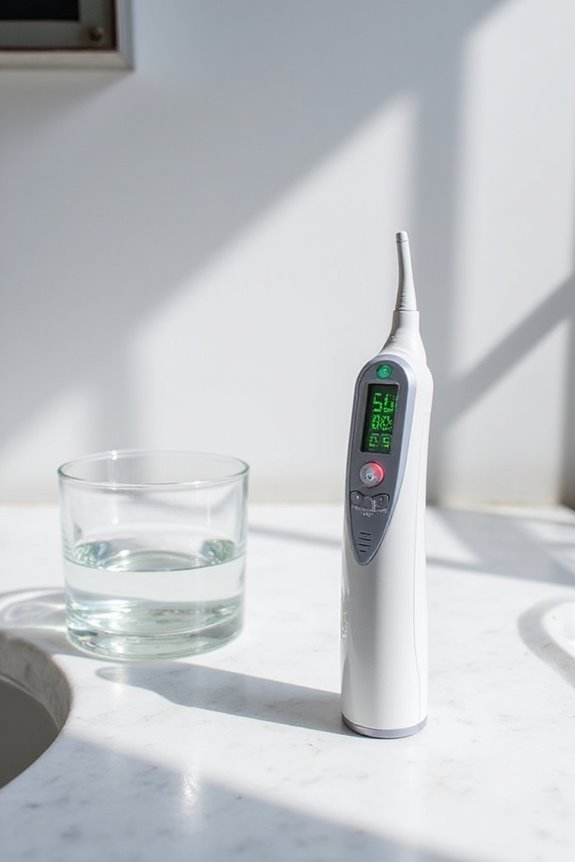
The key features of dual-mode thermometers make them valuable tools in both medical and industrial settings.
Measurement Versatility
- Supports multiple temperature modes: body, surface, ear, forehead, and objects.
- Offers dual measurement units: Celsius and Fahrenheit, with a temperature range from 0°C to 100°C for objects and 32°C to 42.9°C for body/ear.
- Incorporates advanced sensor technology, including dual sensors for precise measurements.
User Interface and Display Features
- Equipped with LCD screens and tri-color indicators for quick visual feedback.
- Stores up to 40 temperature readings for tracking.
Build Quality and Durability
- Constructed from rugged materials, ensuring reliability in diverse environments.
- Ergonomic design enhances user handling for extended use.
Accuracy and Speed: A Crucial Factor
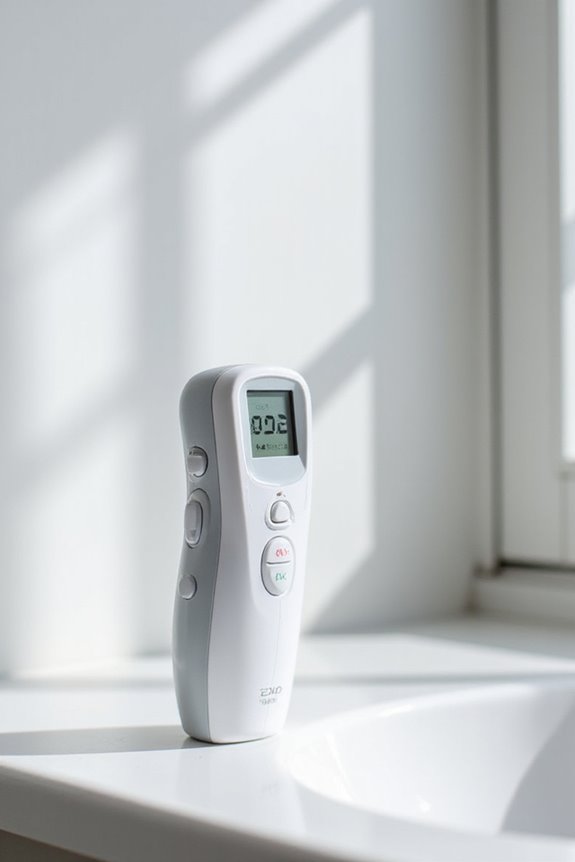
How critical is accuracy and speed in temperature measurement? Accuracy evaluation reveals that clinical digital thermometers provide the highest precision, while infrared (IR) thermometers exhibit variable accuracy, dependent on the anatomical site.
- Dual-mode thermometers combine these technologies, potentially mitigating the drawbacks of each method.
- Speed is notable in IR thermometers, delivering results in as little as one second, contrasting with digital thermometers that take 10 to 90 seconds.
- Dual-mode devices leverage IR speed for rapid initial readings, yet may require time to confirm with digital methods. Additionally, the adjustable emissivity feature in many models enhances measurement accuracy across different materials, making dual-mode thermometers even more reliable in diverse situations.
User Convenience and Ease of Use
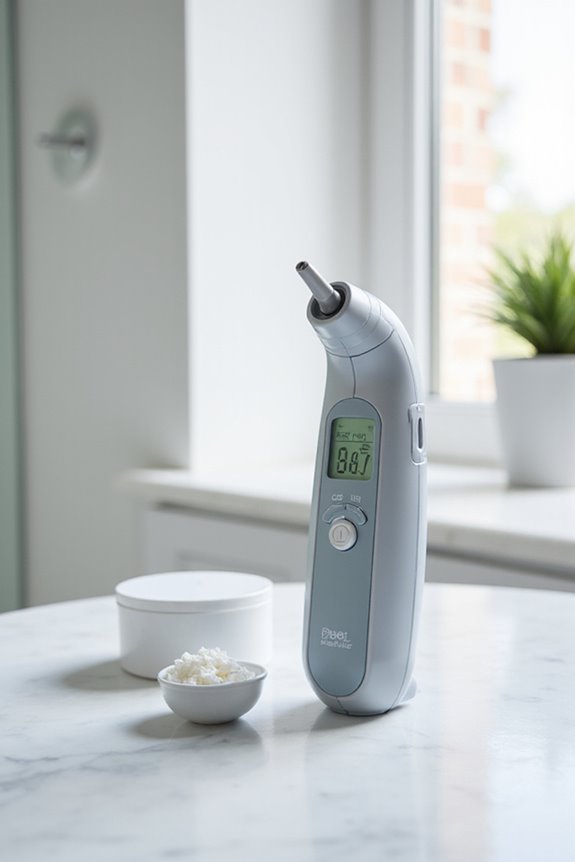
User convenience and ease of use are pivotal aspects in the selection of thermometers, particularly for families and healthcare professionals.
Ergonomic Design
- Special ergonomic designs enable easy one-handed operation, minimizing user error.
- Lightweight and compact, these devices enhance portability.
- Visual and audible indicators support operation in low visibility.
Multi-mode Functionality
- Dual-mode flexibility allows for forehead and ear measurements, reducing the need for multiple devices.
- User-friendly interfaces facilitate quick mode switching.
Display and Feedback Features
- Backlit displays and color-coded fever alerts enhance user experience.
- Adjustable alarm points cater to specific user needs.
Memory and Data Tracking
- Storage for multiple readings simplifies monitoring.
- Memory recall aids in tracking temperature trends.
User feedback consistently highlights these features as essential for convenience.
Hygiene and Safety Benefits
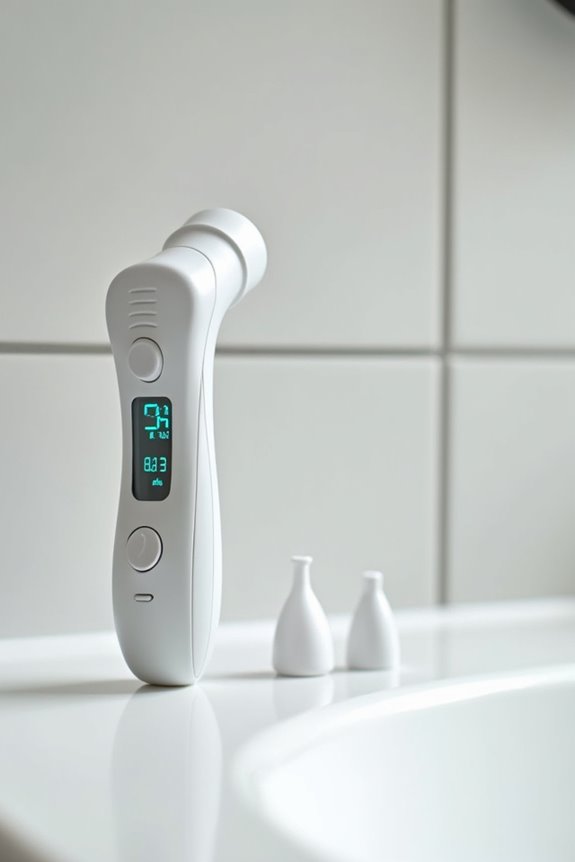
Hygiene and safety benefits present a significant advantage of dual-mode thermometers, particularly in environments where cross-contamination poses a risk.
- Non-contact measurement modes minimize the spread of infections, reducing direct skin contact.
- These thermometers are easier to clean, requiring only alcohol wipes for maintenance, thereby adhering to hygiene practices.
- They are clinically validated and FDA-cleared, ensuring compliance with safety standards across various user demographics.
- Ideal for sensitive populations, these devices prevent discomfort in young children and eliminate risks associated with glass thermometers.
- Their touchless operation is particularly beneficial in shared spaces, enhancing overall safety in schools and healthcare settings.
- With memory functions, they track multiple readings without contamination, reinforcing consistent hygiene practices.
- Additionally, their accuracy within 0.2 degrees of true temperature ensures reliable health assessments, making them a trusted choice for families.
Cost Considerations and Long-Term Value
When evaluating the cost considerations of dual-mode thermometers, it is essential to compare the initial investment with the potential long-term value they provide.
Initial Costs
- Dual-mode thermometers range from $30 to over $100.
- Single-mode devices typically cost under $30.
Long-Term Savings
- Dual-mode thermometers often replace multiple single-mode devices, reducing overall expenses.
- They incur no recurring costs, relying solely on batteries.
Durability and Functionality
- Higher-priced models may offer longer warranties and improved durability.
- Cost effectiveness is enhanced by features such as memory recall, reducing repeated measurements.
Practical Applications for Families and Caregivers
What factors contribute to the practicality of dual-mode thermometers for families and caregivers?
- Versatile Measurement: Capable of measuring both body and external temperatures, these devices cater to all ages, enhancing family health monitoring.
- Child-Friendly Features: Quick readings reduce discomfort in young children, while mute modes allow silent checks during naps.
- Record-Keeping: Many models store up to 50 readings, aiding caregivers in tracking temperature trends and communicating effectively with healthcare providers.
- Safety and Hygiene: Non-contact options minimize cross-contamination risks, vital in multi-person households.
- Convenience: The ability to switch between no-contact and contact modes simplifies caregiving scenarios, providing essential caregiver tips for efficient health management. Additionally, features like large LCD screens enhance visibility and usability, ensuring quick and accurate readings.
Comparing Dual-Mode and Single-Mode Thermometers
In comparing dual-mode and single-mode thermometers, it is essential to evaluate their distinct functionalities and applications.
Sensor Redundancy
- Dual-mode thermometers feature independent sensors, offering redundancy that enhances measurement reliability.
- Malfunction of one sensor does not compromise the entire system, ensuring consistent performance.
Temperature Calibration
- Dual-mode units facilitate temperature calibration without removal from the thermowell, saving time and reducing errors.
- They are ideal for industrial and laboratory settings where precision is critical.
Cost Considerations
- Dual-mode thermometers typically incur higher costs due to advanced technology.
- However, their durability and reduced maintenance needs may justify the investment in high-reliability environments.
Ultimately, the choice between dual-mode and single-mode hinges on specific application requirements and budget constraints.
The Importance of Timely Temperature Monitoring
Timely temperature monitoring plays a critical role in various healthcare settings, impacting both patient safety and treatment efficacy.
- Abnormal body temperatures serve as early infection indicators, particularly for conditions like sepsis.
- Prompt measurement allows healthcare professionals to intervene quickly, reducing potential complications.
- Continuous monitoring is essential for detecting sudden temperature fluctuations, which may signify a patient’s deterioration.
- Regular checks are crucial in managing chronic conditions and post-surgical recovery, ensuring timely identification of infections.
- Automated systems offer 24/7 vigilance, supporting clinical decision-making and improving patient outcomes.
Accurate temperature data underpin effective diagnosis, influencing treatment strategies and enhancing overall care quality. Consequently, timely temperature monitoring is not just beneficial; it is imperative for ideal healthcare delivery.
Making the Right Choice for Your Needs
Choosing the right thermometer requires careful consideration of individual needs and intended use.
Cost vs. Features
- Dual-mode thermometers generally carry a higher price tag due to added functionalities.
- Features such as fever alerts and memory recall enhance usability, justifying additional costs for many users.
Accuracy and Reliability
- These devices provide clinical-grade precision, often within ±0.2°C, essential for accurate temperature monitoring.
- Combining contact and non-contact modes minimizes user error.
Usability and Convenience
- Ergonomic designs and quick readings (typically one second) guarantee ease of use across different dual mode applications.
- Automated features like auto shutoff extend battery life.
Durability
– Premium materials guarantee longevity, particularly in industrial settings, reducing the need for frequent replacements.
Frequently Asked Questions
Can Dual-Mode Thermometers Measure Temperatures in Celsius and Fahrenheit?
Dual-mode thermometers seamlessly facilitate Celsius conversion and Fahrenheit settings, allowing users to switch units effortlessly. This versatility enhances user experience, making temperature readings accessible for diverse households and healthcare settings, fostering a sense of belonging among users.
How Long Do the Batteries Typically Last in Dual-Mode Thermometers?
Battery longevity in dual-mode thermometers varies considerably, with non-rechargeable options lasting hundreds of hours, while rechargeable models offer 18-25 hours. Understanding this balance aids in achieving cost efficiency and ensuring reliable performance for users.
Are Dual-Mode Thermometers Suitable for Newborns or Infants?
Dual-mode thermometers are suitable for newborns and infants, prioritizing newborn safety and infant comfort. Their non-invasive features guarantee accurate readings while minimizing disturbance, making them a valuable tool for caregivers seeking reliable health monitoring solutions.
What Type of Warranty Do Dual-Mode Thermometers Usually Come With?
In the domain of consumer products, dual-mode thermometers typically offer a two-year warranty duration. Warranty comparison among brands reveals subtle differences, but each aims to foster consumer trust and satisfaction through reliable coverage.
Can Dual-Mode Thermometers Be Used for Pets?
Dual-mode thermometers can measure pet temperature, though their accuracy for animals is uncertain. While they offer versatility, dedicated pet thermometers may guarantee more reliable readings, appealing to conscientious pet owners prioritizing their furry companions’ health.




